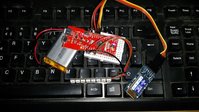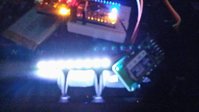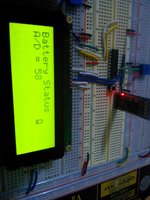This project came out of a few requests in an official news thread for a small device that could tell them when something happened on their Pyra. The general idea was something attached to your arm or a necklace with an LED and a Bluetooth interface. Basically I saw a chance to help through tools I was familiar with and set out to create such a device.
I gathered up some components I had lying around; one SparkFun FioV3 (with a LiPo battery), one Bluefruit EZ-Link and one NeoPixel stick.
It's currently quite physically big, since it's built on a small breadboard with loose components, but the potential for shrinking it down is pretty big. There are many other ATMega32U4 based boards to build this from and LiPo charge/booster circuits are available from various sources. In addition NeoPixels are basically just nicely packaged WS2812 LEDs and while they do get you out of the trouble of soldering SMD components, someone seeking to commercialize this could just put this on the same board as the ATMega32U4. Bluetooth modules can be a handful to deal with but it would not be impossible to adapt the project to suit such modules.
The software is capable of handling output piped from Zenity directly since the latest version (two earlier releases in the news thread), before it used '$' as a prefix for 48 bit color (as in $012345ABCDEF) and '#' for 24 bit (#012345). Now that this is reversed it means you could simply connect to it and issue "zenity --color-selection > /dev/rfcomm0" to make it flash in the color you selected.
I don't have any images or videos of it yet, I'd like to polish the animation a bit more first but if you're interested you could try it on your own Arduino with NeoPixels (for wired usage simply replace all instances of "Serial1" with "Serial"). The source is available for download below.
Even if you can't try it, I'd like to know if this is something you'd be interested in by voting in the poll.
Have a nice day!
Latest version and changelog:
I gathered up some components I had lying around; one SparkFun FioV3 (with a LiPo battery), one Bluefruit EZ-Link and one NeoPixel stick.
It's currently quite physically big, since it's built on a small breadboard with loose components, but the potential for shrinking it down is pretty big. There are many other ATMega32U4 based boards to build this from and LiPo charge/booster circuits are available from various sources. In addition NeoPixels are basically just nicely packaged WS2812 LEDs and while they do get you out of the trouble of soldering SMD components, someone seeking to commercialize this could just put this on the same board as the ATMega32U4. Bluetooth modules can be a handful to deal with but it would not be impossible to adapt the project to suit such modules.
The software is capable of handling output piped from Zenity directly since the latest version (two earlier releases in the news thread), before it used '$' as a prefix for 48 bit color (as in $012345ABCDEF) and '#' for 24 bit (#012345). Now that this is reversed it means you could simply connect to it and issue "zenity --color-selection > /dev/rfcomm0" to make it flash in the color you selected.
I don't have any images or videos of it yet, I'd like to polish the animation a bit more first but if you're interested you could try it on your own Arduino with NeoPixels (for wired usage simply replace all instances of "Serial1" with "Serial"). The source is available for download below.
Even if you can't try it, I'd like to know if this is something you'd be interested in by voting in the poll.
Have a nice day!
Latest version and changelog:
Code:
--- Changelog ---
+ Added
* Changed
- Removed
Version 0:
+ Initial release
Version 1:
+ Pulsing notifications support
initiate by replacing '#' with an uppercase 'P', end by sending "#000000000000"Attachments
Last edited by a moderator:




